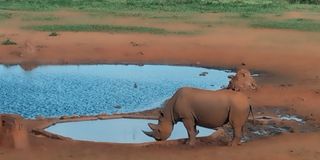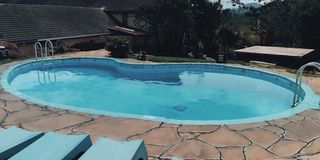Premium
In search of the critically endangered Kenyan black rhino

Black Rhino at Ngulia Rhino Sanctuary Photo| Rupi Mangat
What you need to know:
Rupi Mangat visits Ngulia Rhino Sanctuary in Tsavo West National Park looking for the rare animal
Until the 1950s, our Kenyan black rhino that is the eastern subspecies, Diceros bicornis michaeli was so common that the mega-herbivore was considered a nuisance, especially from Nairobi towards the eastern country that encompasses Ukambani and the great Tsavo.
Then came the call to cull these horned browsers around Ukambani to make space for farms and settlements. The ensuing decades saw the poachers slay the rhino for its horns to fill the demand for the dagger with rhino horn handles, a status symbol of the wealthy Yemeni men thanks to the oil boom. This was followed by the Chinese demand for the horn as an ingredient in traditional Chinese medicine.
All seemed doomed for this horned mammal whose horn is not even a true horn but tightly bound hair until the world woke up to the massacre and called for action. The Kenyan rhino population fell from 18,000 in 1970, to fewer than 400 by 1990.
Our mission in Tsavo West (together with Tsavo East), is to look for the Diceros bicornis michaeli i.e. the Kenyan subspecies. Before the infamous poaching era during the 1970s and 1980s, there were more black rhinos found in Tsavo than anywhere in the world, but by 1990 there were less than 20. The big excitement is to visit the Ngulia Rhino Sanctuary established in 1986 with just nine black rhinos. Shy and solitary, l had never seen one despite multiple visits.
Scanning the plains below with the powerful telescope at Ngulia Safari Lodge, in search of the black rhinos I’m told it’s too hot for them to come out until later in the afternoon when it’s cooler.
So after a sumptuous lunch in the dining room overlooking the great plains below, we’re off driving down the escarpment with the Ngulia Hills spread along the sky. The rhino rangers appear at 4 pm on the dot to allow entry into the fenced area for the rhinos which entails 24-hour guard by dedicated rhino rangers.
We’re greeted by the Maasai giraffes who unknown to many are facing a silent extinction thanks to the bushmeat trade and habitat loss. Estimates are that for every 10 elephants, there is one giraffe.
We’re told by the rhino ranger to head for the new rhino platform by the waterhole where the chances of seeing the rhino are great.
And we are in luck. A large rhino ambles out of the thickets. I have to blink. It’s been decades since I last saw a black rhino in Tsavo West. He leisurely saunters to the waterhole – almost with a swag, in the prime of his youth.
We climb up the steel ladder and onto the open-face banda – complete with a shower and loo that looks out at the waterhole. Our handsome young rhino reaches the waterhole and drinks his fill with his prehensile lip that separates him from the broad-lipped white rhino and then takes a few steps away to flop on the red soils of Tsavo. He’s made our day and he’s in no hurry to get up.
“There are 135-plus black rhinos in the Sanctuary,” tells Fred Nyaanga, the KWS-appointed rhino ranger. The sanctuary has been expanded to take in the increasing number – it’s now 96 square kilometres. The rhino we’re looking at with notched ears has a number and name, as with all the rhinos in the country.
This guy isn’t doing much so we drive further inside the sanctuary. It’s dense with scrub and difficult to see through. With the setting sun, it’s time to leave. “Next time you can spend the night on the platform,” tells Emmanuel Lucky the KWS rhino ranger there. It’s something to look forward to with night vision glasses.
It’s spectacular after the rains in the eastern part of the park. There are herds of elephants trooping to the waterholes dotted around the 9,000 square kilometre park. An enormous eagle has settled on the branch of a tree only to have an elephant youngster make it its scratch tree much to the annoyance of the raptor. It flies away to look for another quieter spot.

Ngulia Rhino Sanctuary lodge
As darkness descends, we settle on the verandah of the first lodge built in the park – Ngulia Safari Lodge opened in 1967. Since then the leopard has been a nightly visitor. On this night, it’s not only one leopard that comes for the bait, but another and in a split-second there is a fierce battle for the bait as the smaller animal is chased away.
Tsavo is timeless with its creatures of the wild.
Fact File
Ngulia Safari Lodge on the escarpment is great for families and all. It’s been renovated and has great staff and food. In Tsavo East, its sister lodge is Voi Safari Lodge in an equally dramatic setting. Contact: 0784 340400 or [email protected]
It’s a great stop-over between Nairobi and Mombasa.
For more on the Ngulia Rhino Sanctuary and spending a night on the rhino viewing platform log onto Tsavo Trust https://tsavotrust.org/
Do you know? The southern black rhino subspecies Diceros bicornis bicornis is extinct in the wild due to poaching and habitat loss.




